
unstructured
Convert documents to structured data effortlessly. Unstructured is open-source ETL solution for transforming complex documents into clean, structured formats for language models. Visit our website to learn more about our enterprise grade Platform product for production grade workflows, partitioning, enrichments, chunking and embedding.
Stars: 12684
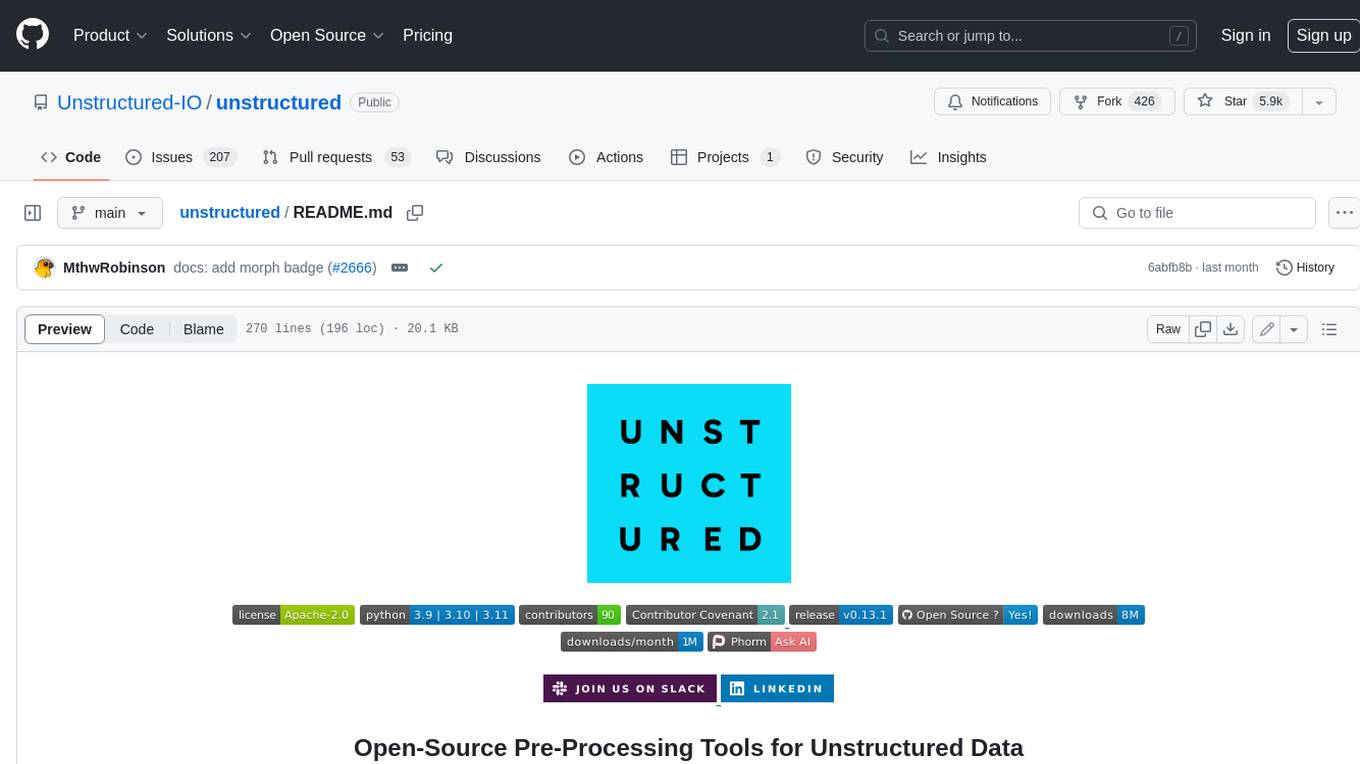
The `unstructured` library provides open-source components for ingesting and pre-processing images and text documents, such as PDFs, HTML, Word docs, and many more. The use cases of `unstructured` revolve around streamlining and optimizing the data processing workflow for LLMs. `unstructured` modular functions and connectors form a cohesive system that simplifies data ingestion and pre-processing, making it adaptable to different platforms and efficient in transforming unstructured data into structured outputs.
README:
Open-Source Pre-Processing Tools for Unstructured Data
The unstructured library provides open-source components for ingesting and pre-processing images and text documents, such as PDFs, HTML, Word docs, and many more. The use cases of unstructured revolve around streamlining and optimizing the data processing workflow for LLMs. unstructured modular functions and connectors form a cohesive system that simplifies data ingestion and pre-processing, making it adaptable to different platforms and efficient in transforming unstructured data into structured outputs.
Ready to move your data processing pipeline to production, and take advantage of advanced features? Check out Unstructured Platform. In addition to better processing performance, take advantage of chunking, embedding, and image and table enrichment generation, all from a low code UI or an API. Request a demo from our sales team to learn more about how to get started.
There are several ways to use the unstructured library:
- Run the library in a container or
- Install the library
- For installation with
condaon Windows system, please refer to the documentation
The following instructions are intended to help you get up and running using Docker to interact with unstructured.
See here if you don't already have docker installed on your machine.
NOTE: we build multi-platform images to support both x86_64 and Apple silicon hardware. docker pull should download the corresponding image for your architecture, but you can specify with --platform (e.g. --platform linux/amd64) if needed.
We build Docker images for all pushes to main. We tag each image with the corresponding short commit hash (e.g. fbc7a69) and the application version (e.g. 0.5.5-dev1). We also tag the most recent image with latest. To leverage this, docker pull from our image repository.
docker pull downloads.unstructured.io/unstructured-io/unstructured:latestOnce pulled, you can create a container from this image and shell to it.
# create the container
docker run -dt --name unstructured downloads.unstructured.io/unstructured-io/unstructured:latest
# this will drop you into a bash shell where the Docker image is running
docker exec -it unstructured bashYou can also build your own Docker image. Note that the base image is wolfi-base, which is
updated regularly. If you are building the image locally, it is possible docker-build could
fail due to upstream changes in wolfi-base.
If you only plan on parsing one type of data you can speed up building the image by commenting out some of the packages/requirements necessary for other data types. See Dockerfile to know which lines are necessary for your use case.
make docker-build
# this will drop you into a bash shell where the Docker image is running
make docker-start-bashOnce in the running container, you can try things directly in Python interpreter's interactive mode.
# this will drop you into a python console so you can run the below partition functions
python3
>>> from unstructured.partition.pdf import partition_pdf
>>> elements = partition_pdf(filename="example-docs/layout-parser-paper-fast.pdf")
>>> from unstructured.partition.text import partition_text
>>> elements = partition_text(filename="example-docs/fake-text.txt")Use the following instructions to get up and running with unstructured and test your
installation.
-
Install the Python SDK to support all document types with
pip install "unstructured[all-docs]"- For plain text files, HTML, XML, JSON and Emails that do not require any extra dependencies, you can run
pip install unstructured - To process other doc types, you can install the extras required for those documents, such as
pip install "unstructured[docx,pptx]"
- For plain text files, HTML, XML, JSON and Emails that do not require any extra dependencies, you can run
-
Install the following system dependencies if they are not already available on your system. Depending on what document types you're parsing, you may not need all of these.
-
libmagic-dev(filetype detection) -
poppler-utils(images and PDFs) -
tesseract-ocr(images and PDFs, installtesseract-langfor additional language support) -
libreoffice(MS Office docs) -
pandoc(EPUBs, RTFs and Open Office docs). Please note that to handle RTF files, you need version2.14.2or newer. Running eithermake install-pandocor./scripts/install-pandoc.shwill install the correct version for you.
-
-
For suggestions on how to install on the Windows and to learn about dependencies for other features, see the installation documentation here.
At this point, you should be able to run the following code:
from unstructured.partition.auto import partition
elements = partition(filename="example-docs/eml/fake-email.eml")
print("\n\n".join([str(el) for el in elements]))The following instructions are intended to help you get up and running with unstructured
locally if you are planning to contribute to the project.
-
Using
pyenvto manage virtualenv's is recommended but not necessary -
Create a virtualenv to work in and activate it, e.g. for one named
unstructured:pyenv virtualenv 3.10 unstructured
pyenv activate unstructured -
Run
make install -
Optional:
- To install models and dependencies for processing images and PDFs locally, run
make install-local-inference. - For processing image files,
tesseractis required. See here for installation instructions. - For processing PDF files,
tesseractandpopplerare required. The pdf2image docs have instructions on installingpoppleracross various platforms.
- To install models and dependencies for processing images and PDFs locally, run
Additionally, if you're planning to contribute to unstructured, we provide you an optional pre-commit configuration
file to ensure your code matches the formatting and linting standards used in unstructured.
If you'd prefer not to have code changes auto-tidied before every commit, you can use make check to see
whether any linting or formatting changes should be applied, and make tidy to apply them.
If using the optional pre-commit, you'll just need to install the hooks with pre-commit install since the
pre-commit package is installed as part of make install mentioned above. Finally, if you decided to use pre-commit
you can also uninstall the hooks with pre-commit uninstall.
In addition to develop in your local OS we also provide a helper to use docker providing a development environment:
make docker-start-devThis starts a docker container with your local repo mounted to /mnt/local_unstructured. This docker image allows you to develop without worrying about your OS's compatibility with the repo and its dependencies.
For more comprehensive documentation, visit https://docs.unstructured.io . You can also learn more about our other products on the documentation page, including our SaaS API.
Here are a few pages from the Open Source documentation page that are helpful for new users to review:
The following examples show how to get started with the unstructured library. The easiest way to parse a document in unstructured is to use the partition function. If you use partition function, unstructured will detect the file type and route it to the appropriate file-specific partitioning function. If you are using the partition function, you may need to install additional dependencies per doc type.
For example, to install docx dependencies you need to run pip install "unstructured[docx]".
See our installation guide for more details.
from unstructured.partition.auto import partition
elements = partition("example-docs/layout-parser-paper.pdf")Run print("\n\n".join([str(el) for el in elements])) to get a string representation of the
output, which looks like:
LayoutParser : A Unified Toolkit for Deep Learning Based Document Image Analysis
Zejiang Shen 1 ( (cid:0) ), Ruochen Zhang 2 , Melissa Dell 3 , Benjamin Charles Germain Lee 4 , Jacob Carlson 3 , and
Weining Li 5
Abstract. Recent advances in document image analysis (DIA) have been primarily driven by the application of neural
networks. Ideally, research outcomes could be easily deployed in production and extended for further investigation.
However, various factors like loosely organized codebases and sophisticated model configurations complicate the easy
reuse of important innovations by a wide audience. Though there have been ongoing efforts to improve reusability and
simplify deep learning (DL) model development in disciplines like natural language processing and computer vision, none
of them are optimized for challenges in the domain of DIA. This represents a major gap in the existing toolkit, as DIA
is central to academic research across a wide range of disciplines in the social sciences and humanities. This paper
introduces LayoutParser, an open-source library for streamlining the usage of DL in DIA research and applications.
The core LayoutParser library comes with a set of simple and intuitive interfaces for applying and customizing DL models
for layout detection, character recognition, and many other document processing tasks. To promote extensibility,
LayoutParser also incorporates a community platform for sharing both pre-trained models and full document digitization
pipelines. We demonstrate that LayoutParser is helpful for both lightweight and large-scale digitization pipelines in
real-word use cases. The library is publicly available at https://layout-parser.github.io
Keywords: Document Image Analysis · Deep Learning · Layout Analysis · Character Recognition · Open Source library ·
Toolkit.
Introduction
Deep Learning(DL)-based approaches are the state-of-the-art for a wide range of document image analysis (DIA) tasks
including document image classification [11,
See the partitioning section in our documentation for a full list of options and instructions on how to use file-specific partitioning functions.
See our security policy for information on how to report security vulnerabilities.
Encountered a bug? Please create a new GitHub issue and use our bug report template to describe the problem. To help us diagnose the issue, use the python scripts/collect_env.py command to gather your system's environment information and include it in your report. Your assistance helps us continuously improve our software - thank you!
| Section | Description |
|---|---|
| Company Website | Unstructured.io product and company info |
| Documentation | Full API documentation |
| Batch Processing | Ingesting batches of documents through Unstructured |
This library includes a very lightweight analytics "ping" when the library is loaded, however you can opt out of this data collection by setting the environment variable DO_NOT_TRACK=true before executing any unstructured code. To learn more about how we collect and use this data, please read our Privacy Policy.
For Tasks:
Click tags to check more tools for each tasksFor Jobs:
Alternative AI tools for unstructured
Similar Open Source Tools

unstructured
The `unstructured` library provides open-source components for ingesting and pre-processing images and text documents, such as PDFs, HTML, Word docs, and many more. The use cases of `unstructured` revolve around streamlining and optimizing the data processing workflow for LLMs. `unstructured` modular functions and connectors form a cohesive system that simplifies data ingestion and pre-processing, making it adaptable to different platforms and efficient in transforming unstructured data into structured outputs.
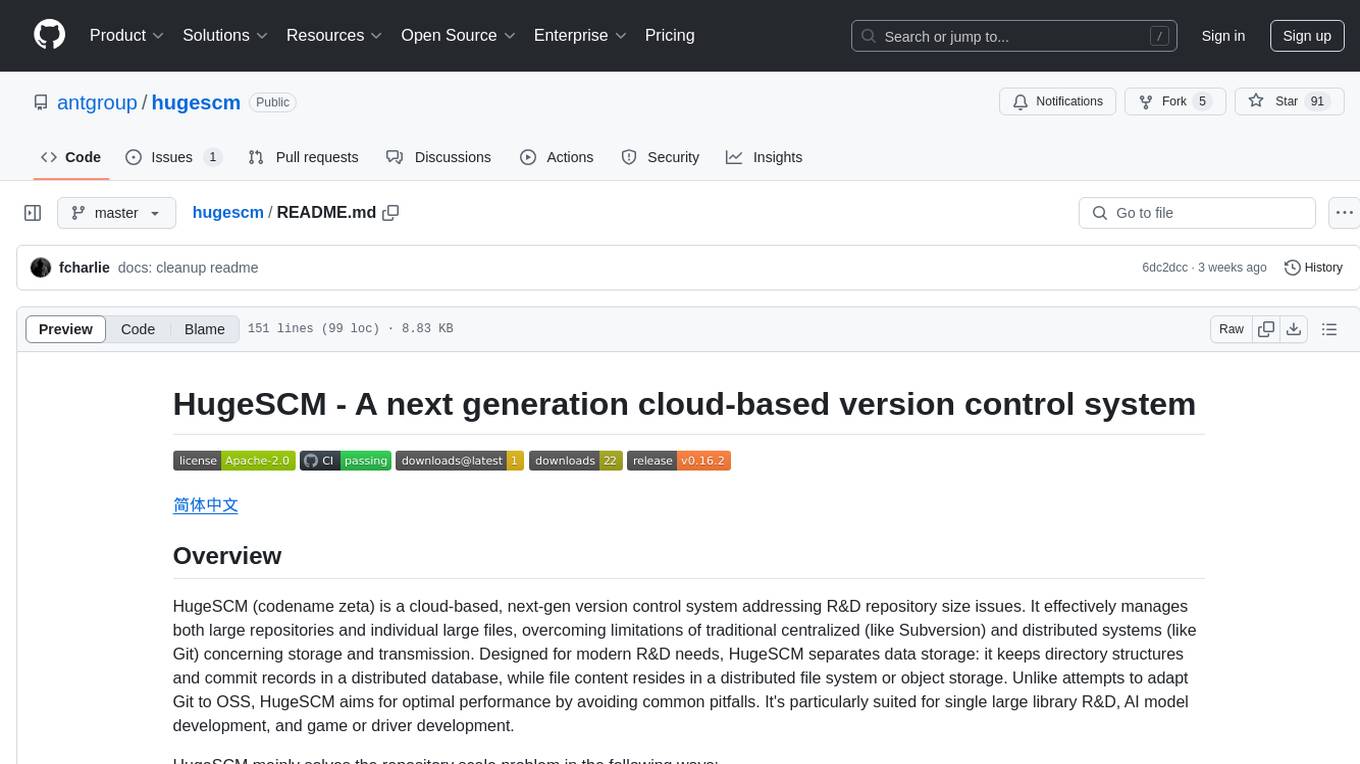
hugescm
HugeSCM is a cloud-based version control system designed to address R&D repository size issues. It effectively manages large repositories and individual large files by separating data storage and utilizing advanced algorithms and data structures. It aims for optimal performance in handling version control operations of large-scale repositories, making it suitable for single large library R&D, AI model development, and game or driver development.
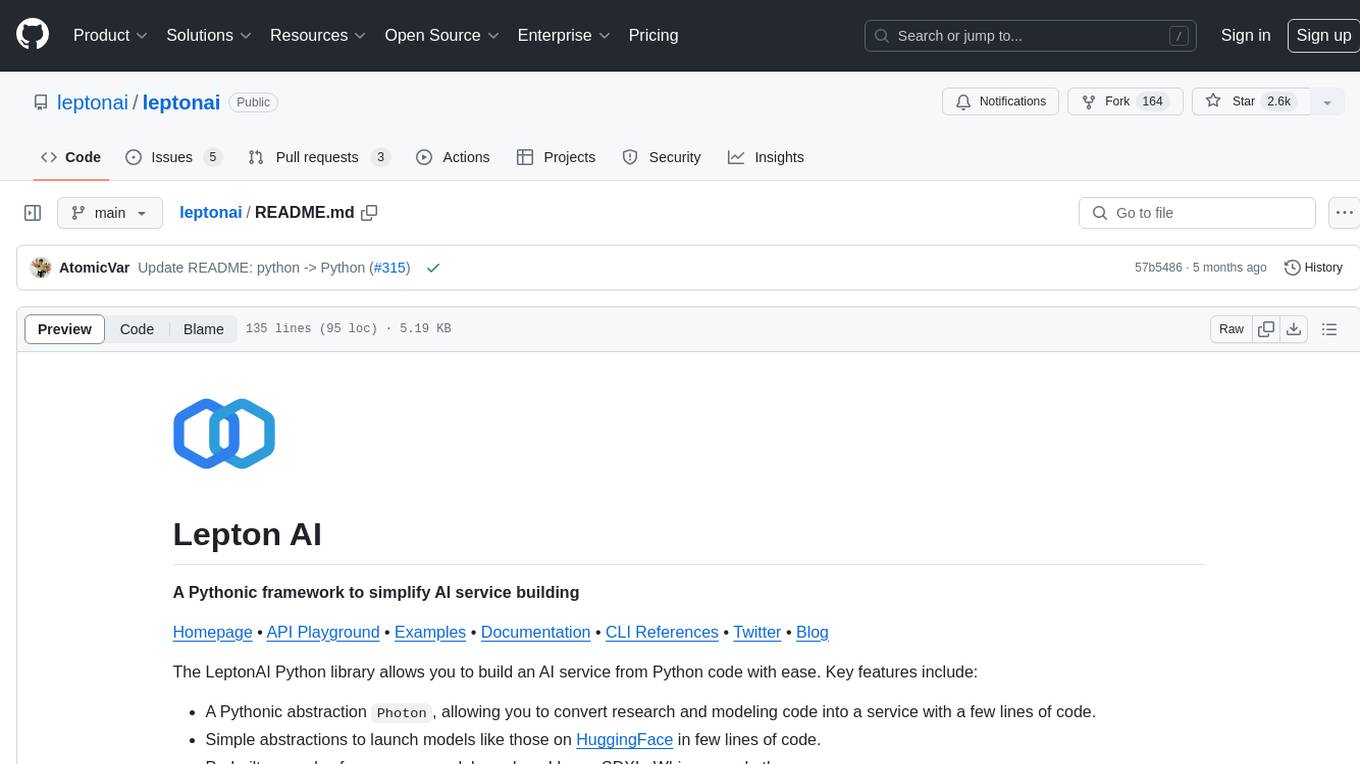
leptonai
A Pythonic framework to simplify AI service building. The LeptonAI Python library allows you to build an AI service from Python code with ease. Key features include a Pythonic abstraction Photon, simple abstractions to launch models like those on HuggingFace, prebuilt examples for common models, AI tailored batteries, a client to automatically call your service like native Python functions, and Pythonic configuration specs to be readily shipped in a cloud environment.
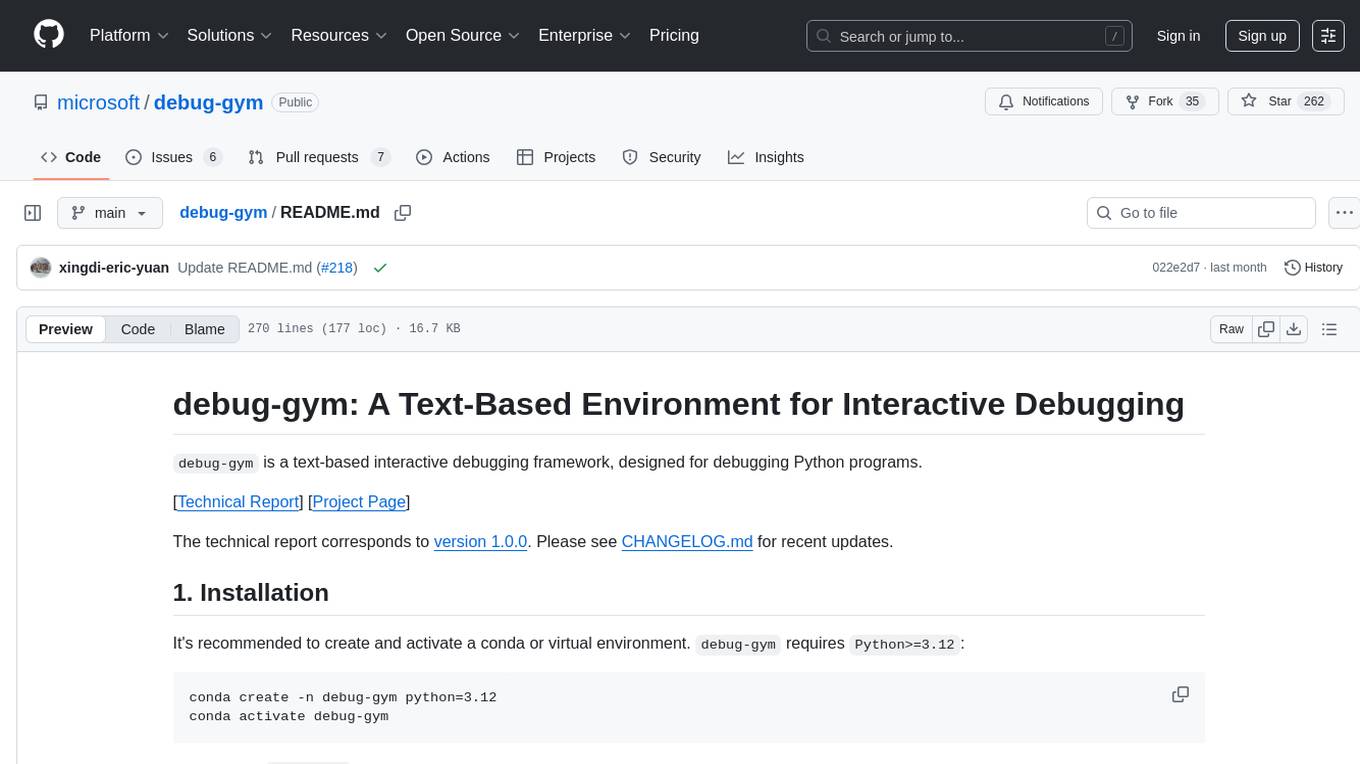
debug-gym
debug-gym is a text-based interactive debugging framework designed for debugging Python programs. It provides an environment where agents can interact with code repositories, use various tools like pdb and grep to investigate and fix bugs, and propose code patches. The framework supports different LLM backends such as OpenAI, Azure OpenAI, and Anthropic. Users can customize tools, manage environment states, and run agents to debug code effectively. debug-gym is modular, extensible, and suitable for interactive debugging tasks in a text-based environment.
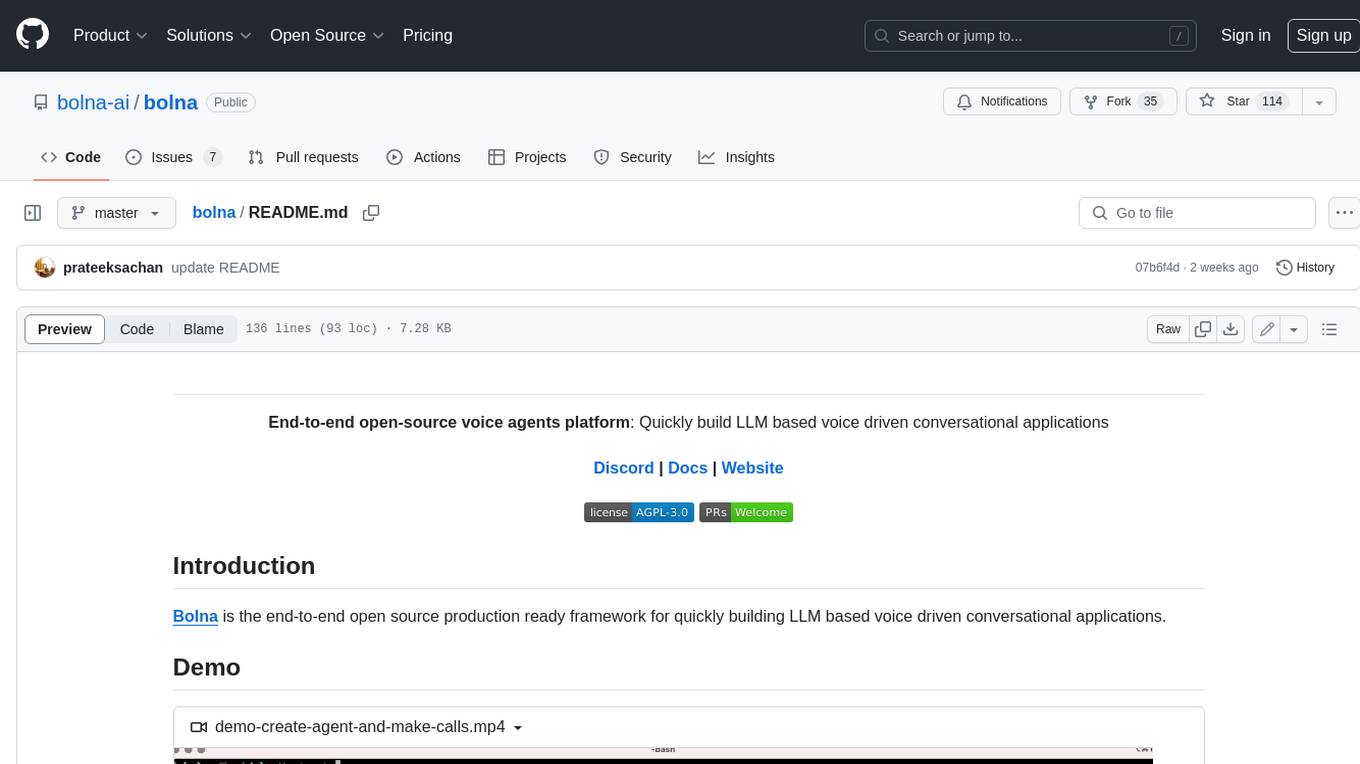
bolna
Bolna is an open-source platform for building voice-driven conversational applications using large language models (LLMs). It provides a comprehensive set of tools and integrations to handle various aspects of voice-based interactions, including telephony, transcription, LLM-based conversation handling, and text-to-speech synthesis. Bolna simplifies the process of creating voice agents that can perform tasks such as initiating phone calls, transcribing conversations, generating LLM-powered responses, and synthesizing speech. It supports multiple providers for each component, allowing users to customize their setup based on their specific needs. Bolna is designed to be easy to use, with a straightforward local setup process and well-documented APIs. It is also extensible, enabling users to integrate with other telephony providers or add custom functionality.
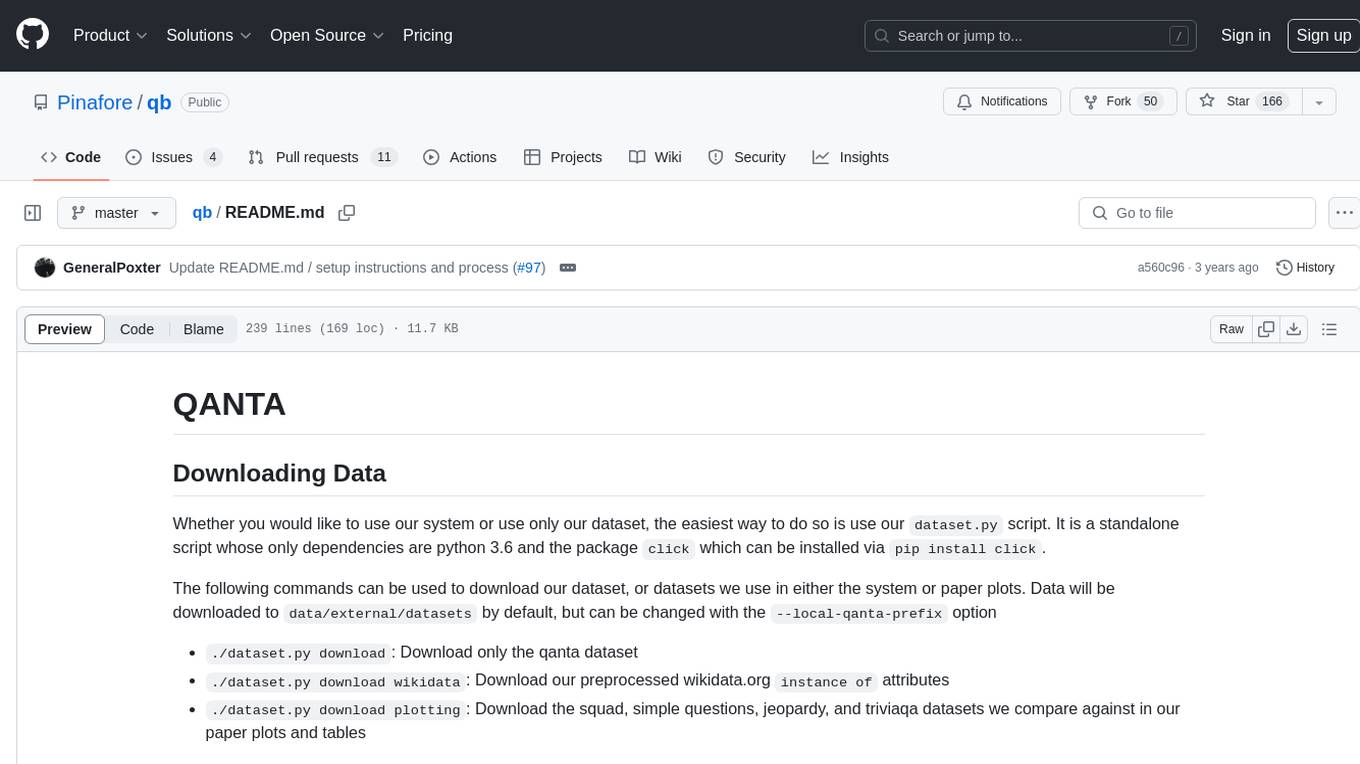
qb
QANTA is a system and dataset for question answering tasks. It provides a script to download datasets, preprocesses questions, and matches them with Wikipedia pages. The system includes various datasets, training, dev, and test data in JSON and SQLite formats. Dependencies include Python 3.6, `click`, and NLTK models. Elastic Search 5.6 is needed for the Guesser component. Configuration is managed through environment variables and YAML files. QANTA supports multiple guesser implementations that can be enabled/disabled. Running QANTA involves using `cli.py` and Luigi pipelines. The system accesses raw Wikipedia dumps for data processing. The QANTA ID numbering scheme categorizes datasets based on events and competitions.
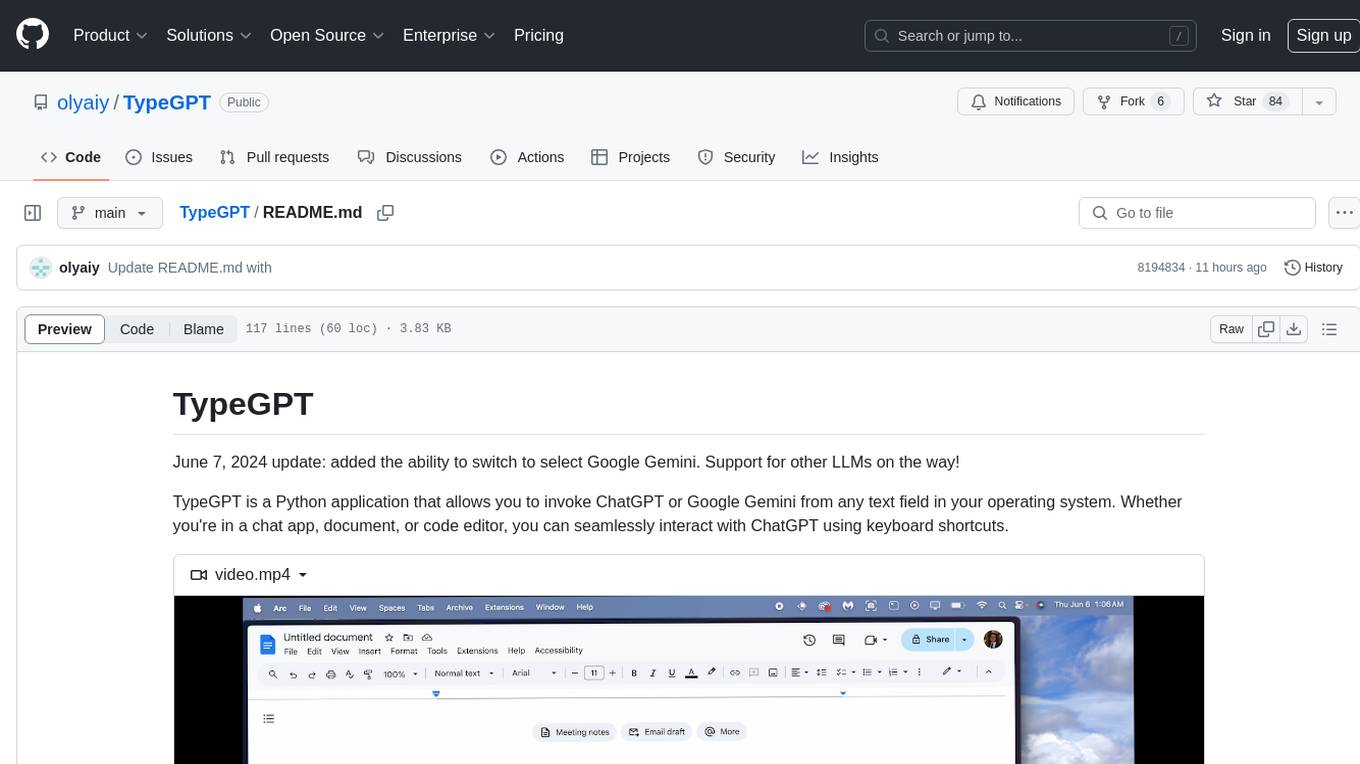
TypeGPT
TypeGPT is a Python application that enables users to interact with ChatGPT or Google Gemini from any text field in their operating system using keyboard shortcuts. It provides global accessibility, keyboard shortcuts for communication, and clipboard integration for larger text inputs. Users need to have Python 3.x installed along with specific packages and API keys from OpenAI for ChatGPT access. The tool allows users to run the program normally or in the background, manage processes, and stop the program. Users can use keyboard shortcuts like `/ask`, `/see`, `/stop`, `/chatgpt`, `/gemini`, `/check`, and `Shift + Cmd + Enter` to interact with the application in any text field. Customization options are available by modifying files like `keys.txt` and `system_prompt.txt`. Contributions are welcome, and future plans include adding support for other APIs and a user-friendly GUI.
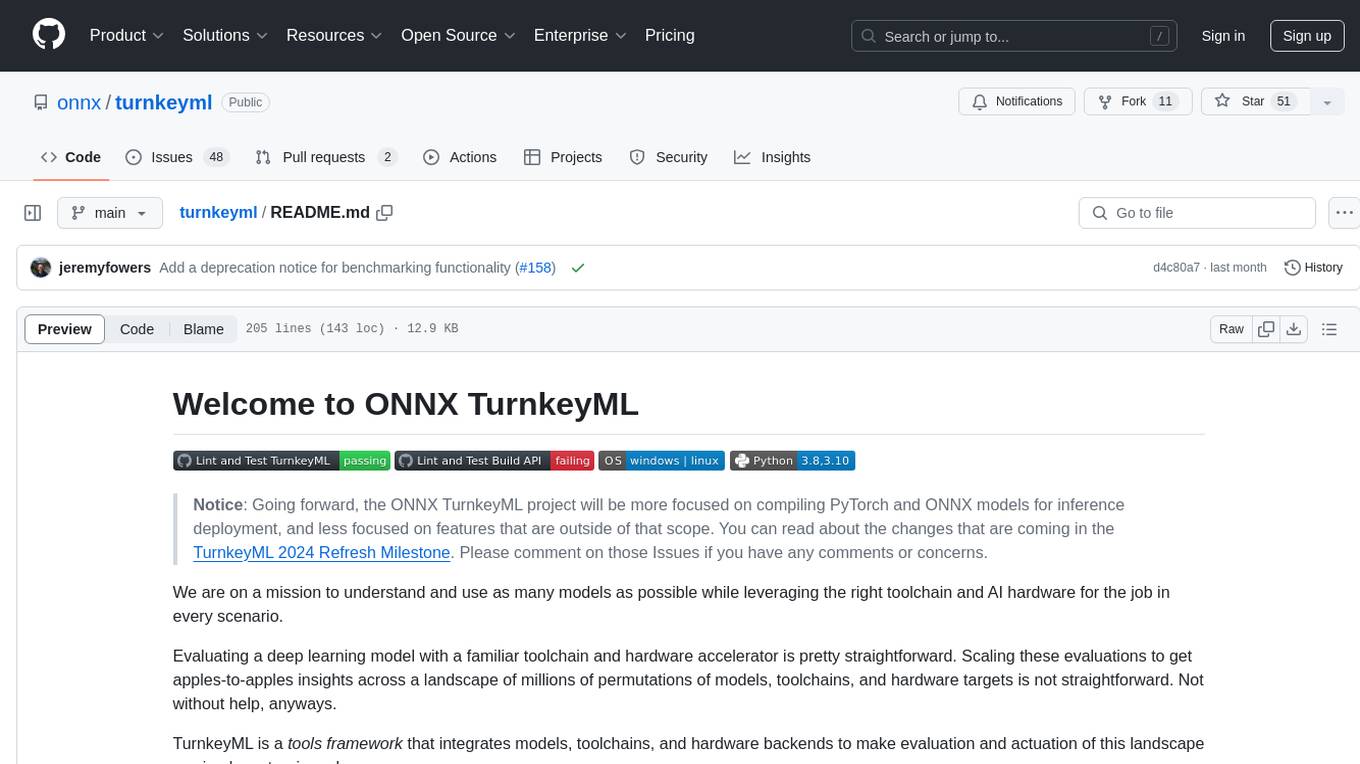
turnkeyml
TurnkeyML is a tools framework that integrates models, toolchains, and hardware backends to simplify the evaluation and actuation of deep learning models. It supports use cases like exporting ONNX files, performance validation, functional coverage measurement, stress testing, and model insights analysis. The framework consists of analysis, build, runtime, reporting tools, and a models corpus, seamlessly integrated to provide comprehensive functionality with simple commands. Extensible through plugins, it offers support for various export and optimization tools and AI runtimes. The project is actively seeking collaborators and is licensed under Apache 2.0.
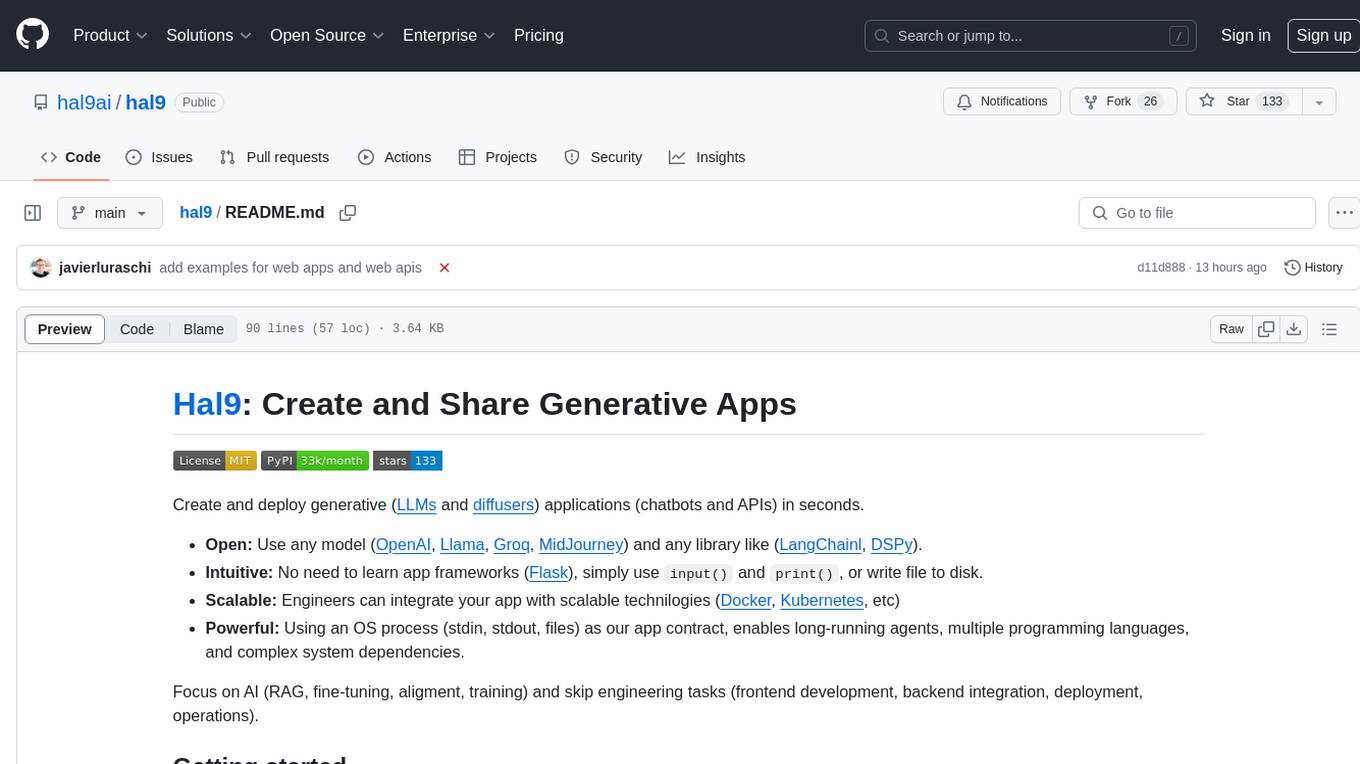
hal9
Hal9 is a tool that allows users to create and deploy generative applications such as chatbots and APIs quickly. It is open, intuitive, scalable, and powerful, enabling users to use various models and libraries without the need to learn complex app frameworks. With a focus on AI tasks like RAG, fine-tuning, alignment, and training, Hal9 simplifies the development process by skipping engineering tasks like frontend development, backend integration, deployment, and operations.
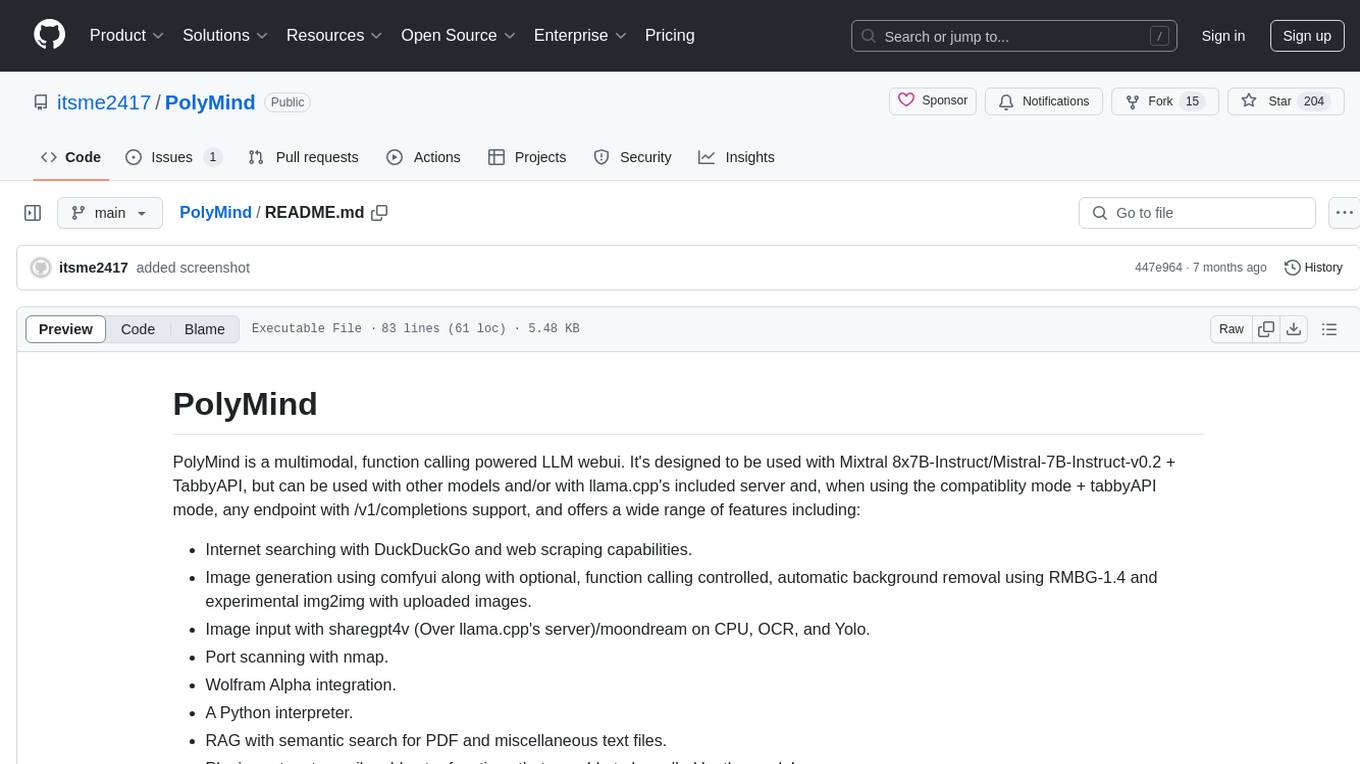
PolyMind
PolyMind is a multimodal, function calling powered LLM webui designed for various tasks such as internet searching, image generation, port scanning, Wolfram Alpha integration, Python interpretation, and semantic search. It offers a plugin system for adding extra functions and supports different models and endpoints. The tool allows users to interact via function calling and provides features like image input, image generation, and text file search. The application's configuration is stored in a `config.json` file with options for backend selection, compatibility mode, IP address settings, API key, and enabled features.
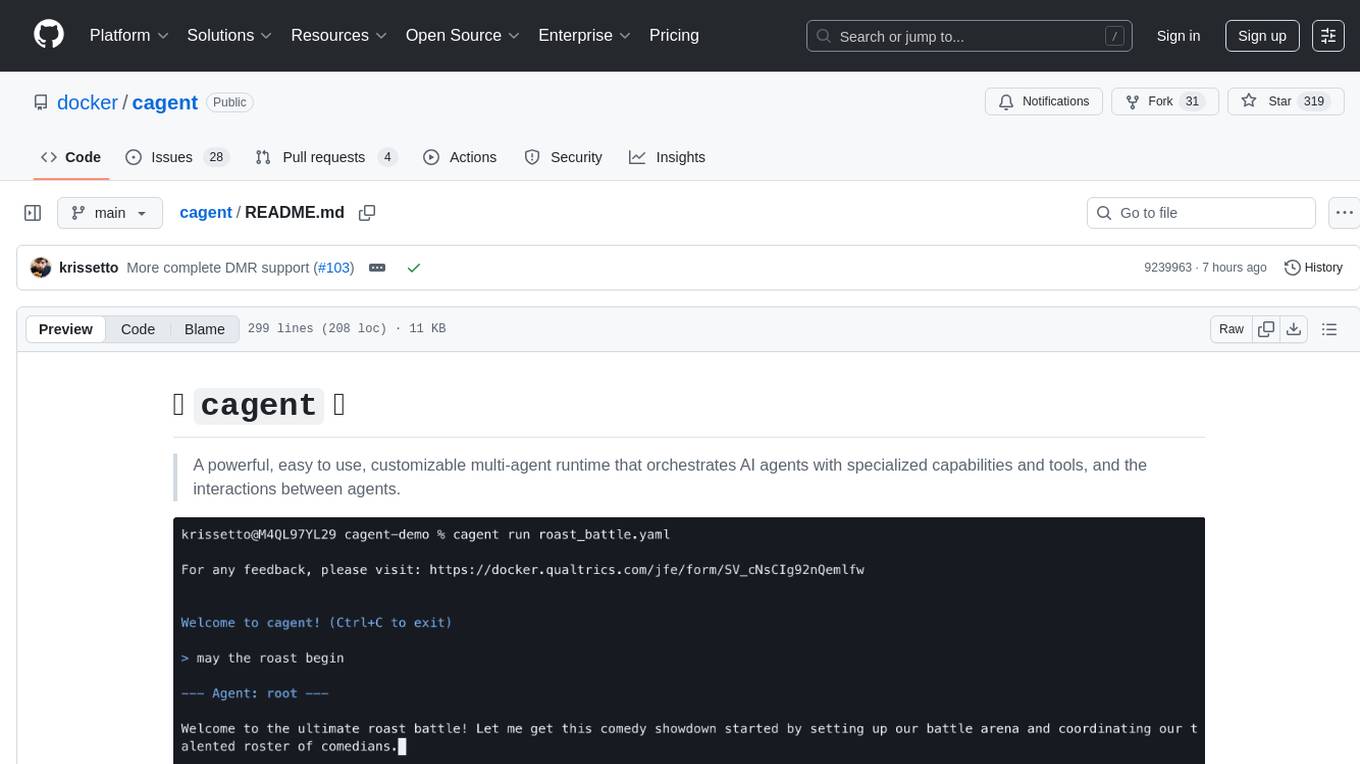
cagent
cagent is a powerful and easy-to-use multi-agent runtime that orchestrates AI agents with specialized capabilities and tools, allowing users to quickly build, share, and run a team of virtual experts to solve complex problems. It supports creating agents with YAML configuration, improving agents with MCP servers, and delegating tasks to specialists. Key features include multi-agent architecture, rich tool ecosystem, smart delegation, YAML configuration, advanced reasoning tools, and support for multiple AI providers like OpenAI, Anthropic, Gemini, and Docker Model Runner.
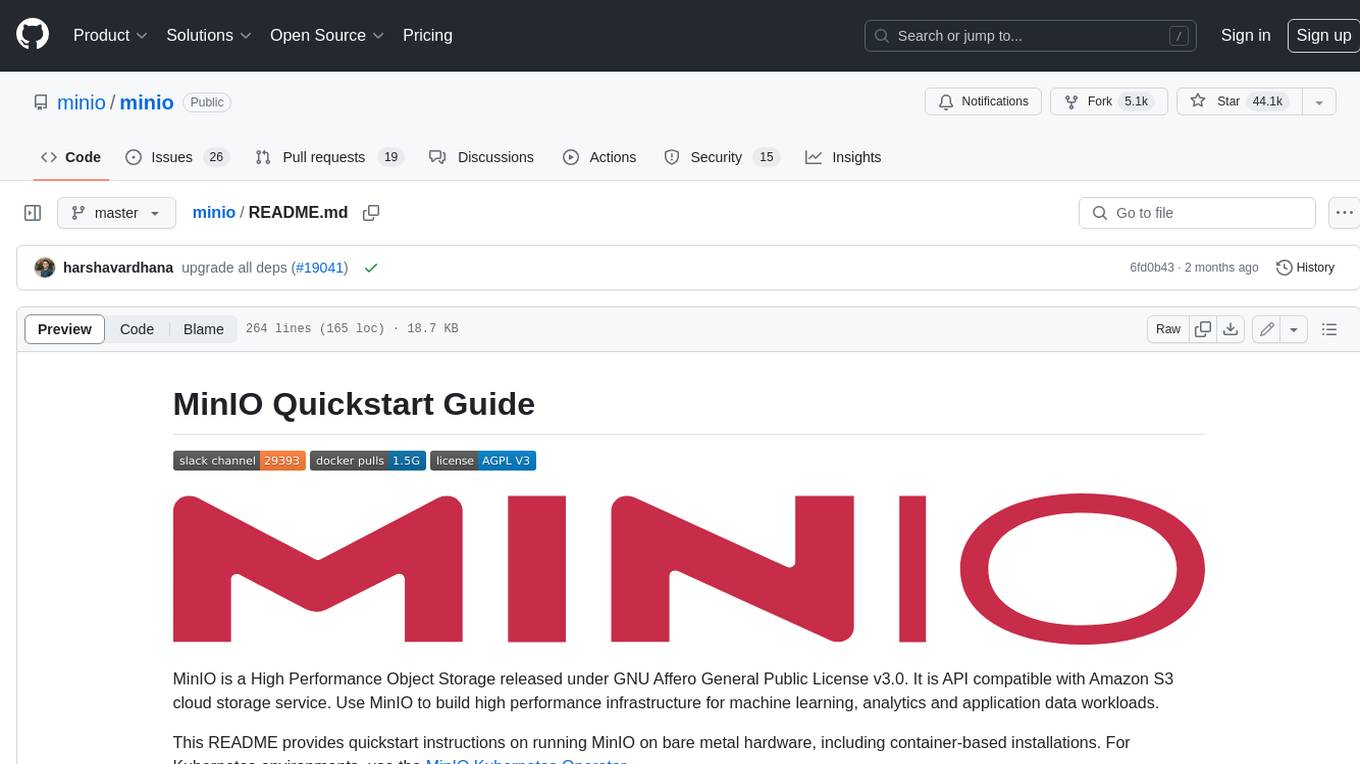
minio
MinIO is a High Performance Object Storage released under GNU Affero General Public License v3.0. It is API compatible with Amazon S3 cloud storage service. Use MinIO to build high performance infrastructure for machine learning, analytics and application data workloads.
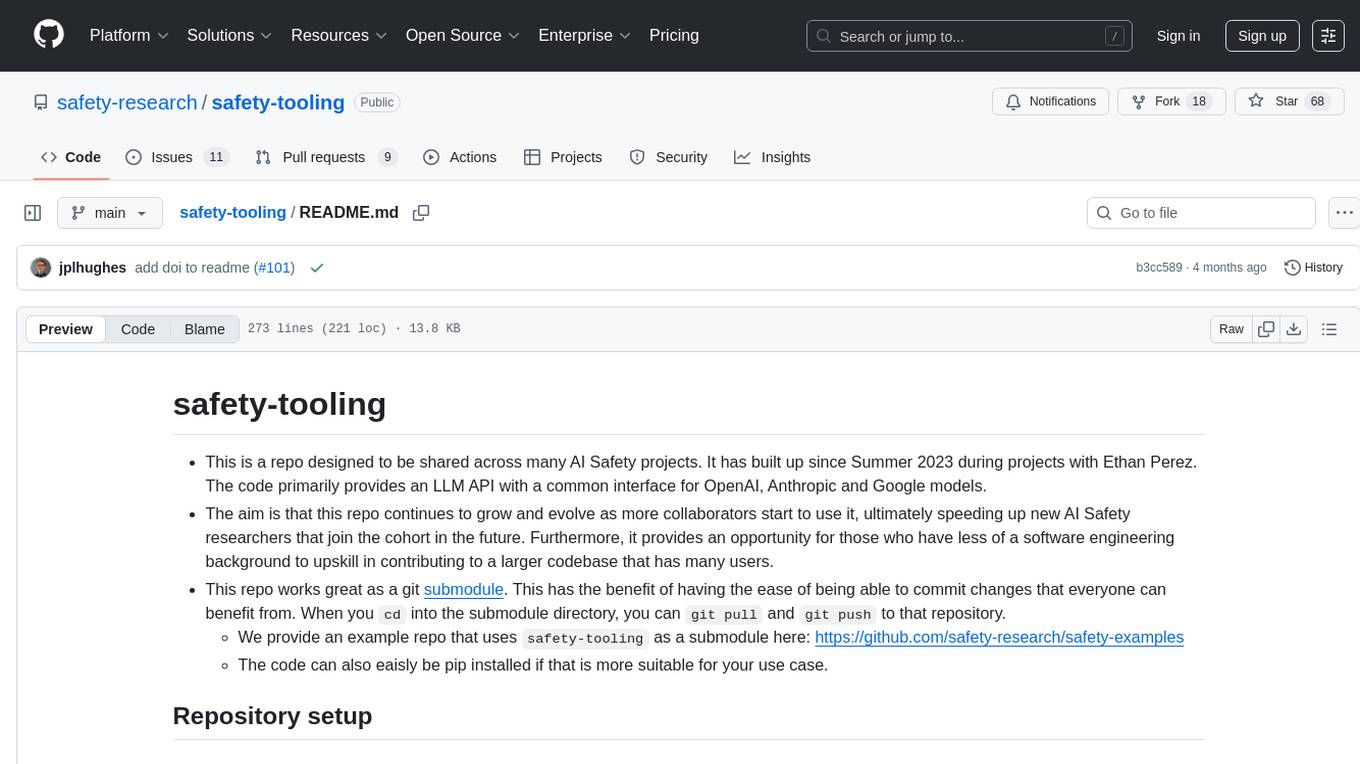
safety-tooling
This repository, safety-tooling, is designed to be shared across various AI Safety projects. It provides an LLM API with a common interface for OpenAI, Anthropic, and Google models. The aim is to facilitate collaboration among AI Safety researchers, especially those with limited software engineering backgrounds, by offering a platform for contributing to a larger codebase. The repo can be used as a git submodule for easy collaboration and updates. It also supports pip installation for convenience. The repository includes features for installation, secrets management, linting, formatting, Redis configuration, testing, dependency management, inference, finetuning, API usage tracking, and various utilities for data processing and experimentation.
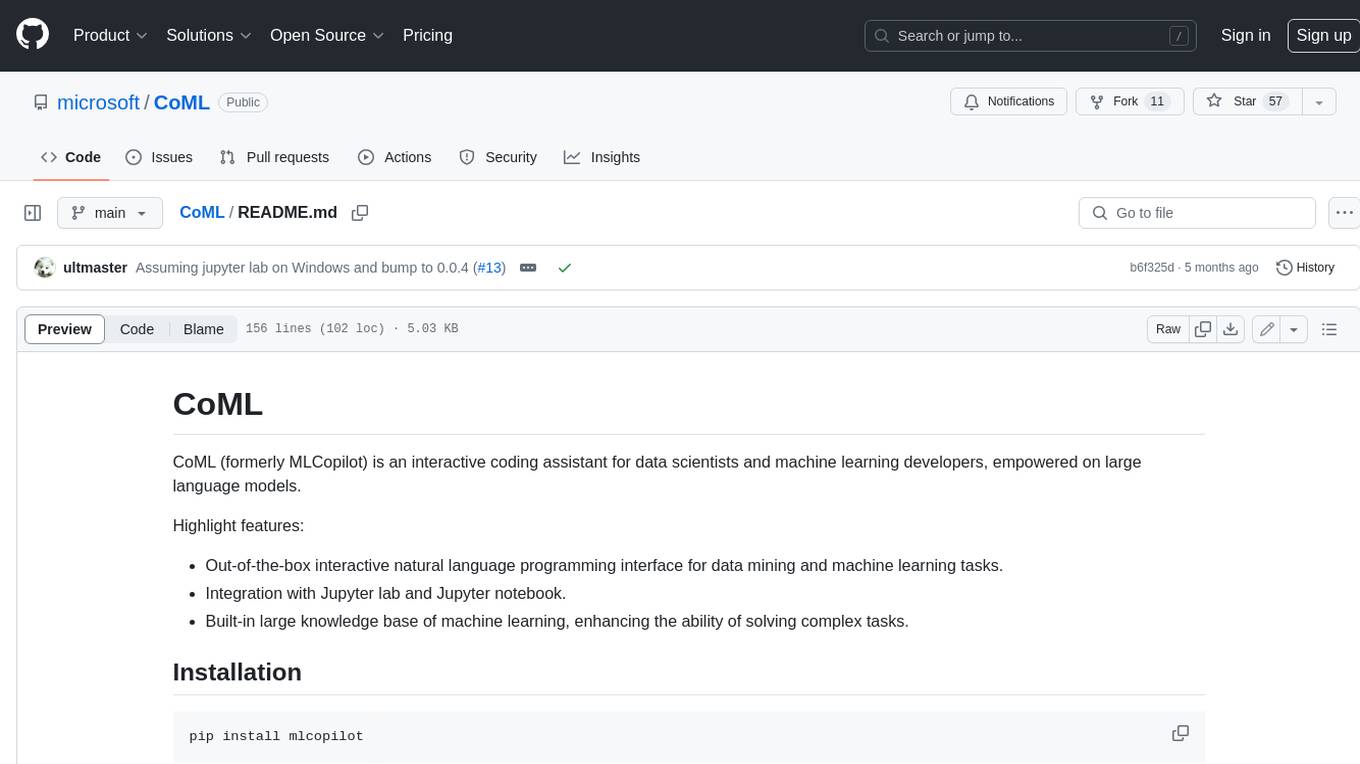
CoML
CoML (formerly MLCopilot) is an interactive coding assistant for data scientists and machine learning developers, empowered on large language models. It offers an out-of-the-box interactive natural language programming interface for data mining and machine learning tasks, integration with Jupyter lab and Jupyter notebook, and a built-in large knowledge base of machine learning to enhance the ability to solve complex tasks. The tool is designed to assist users in coding tasks related to data analysis and machine learning using natural language commands within Jupyter environments.
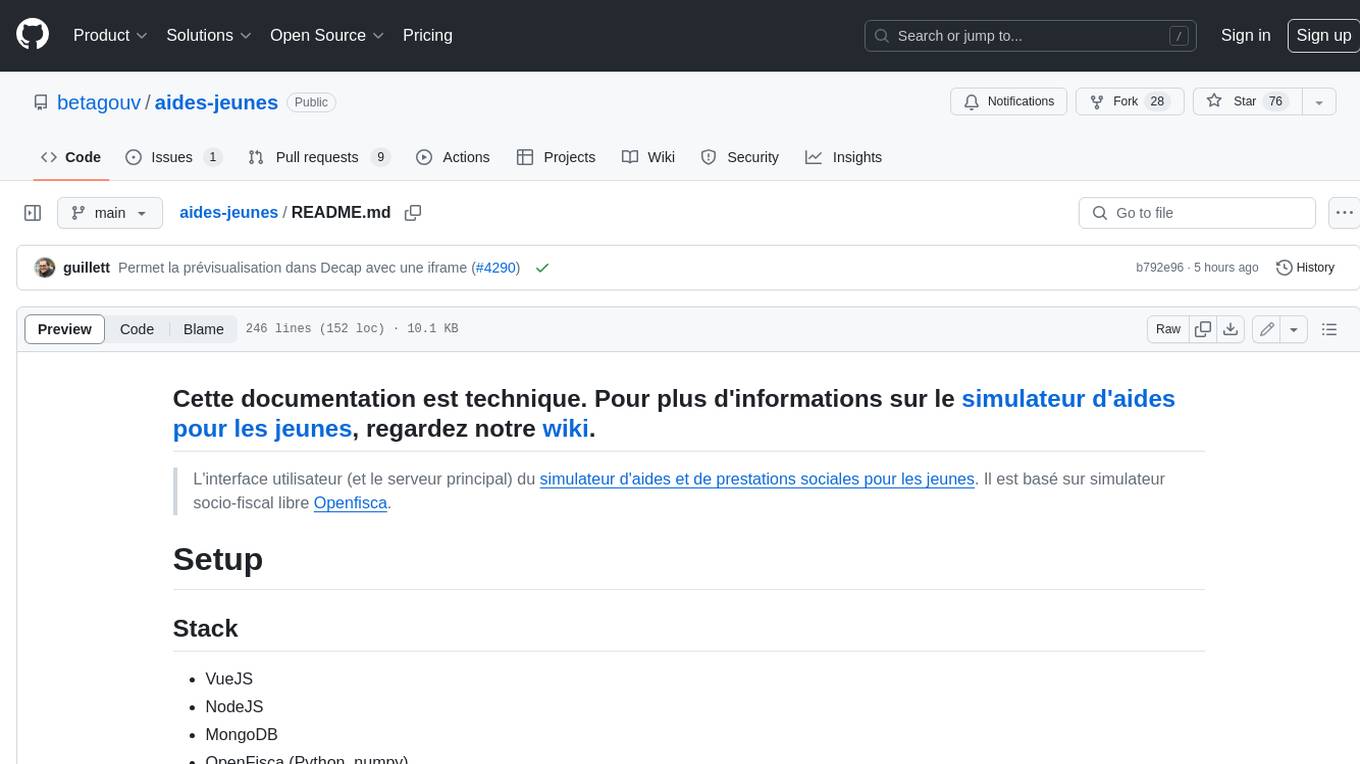
aides-jeunes
The user interface (and the main server) of the simulator of aids and social benefits for young people. It is based on the free socio-fiscal simulator Openfisca.
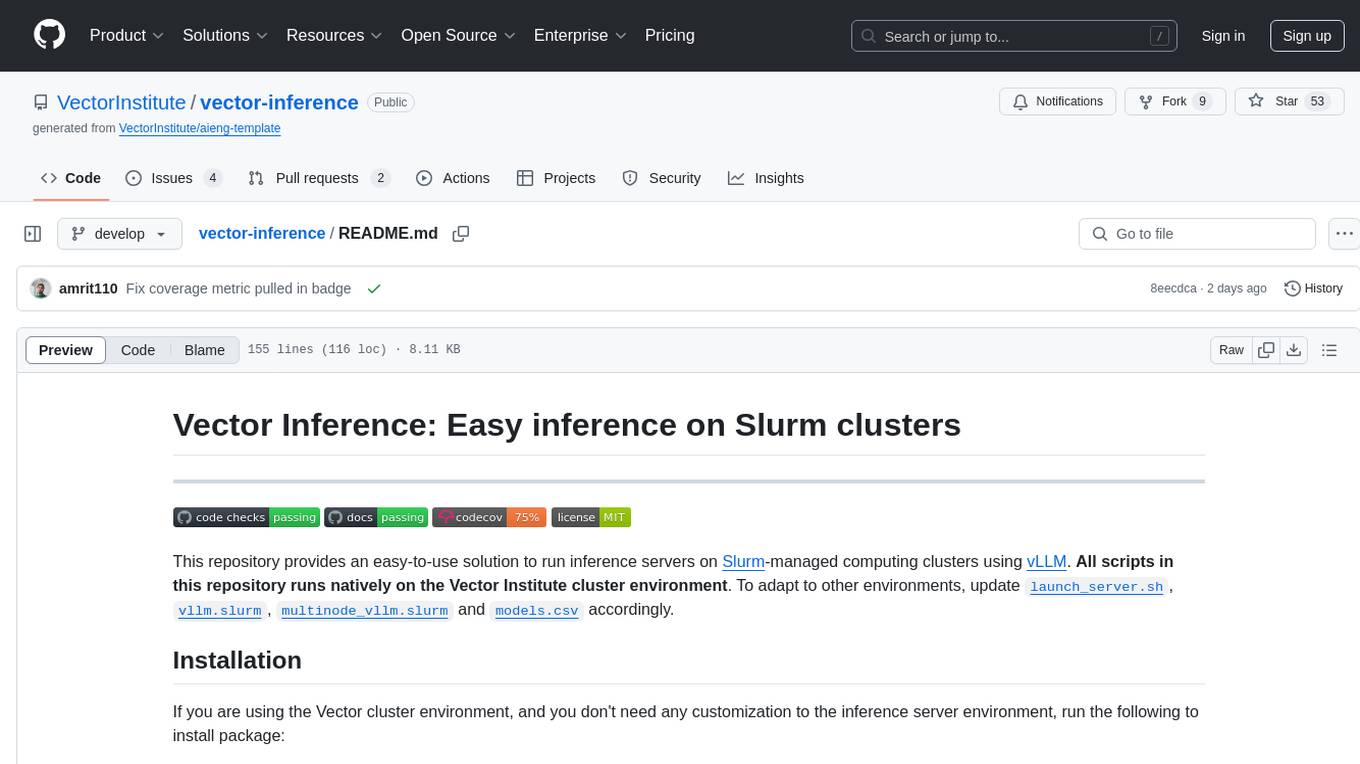
vector-inference
This repository provides an easy-to-use solution for running inference servers on Slurm-managed computing clusters using vLLM. All scripts in this repository run natively on the Vector Institute cluster environment. Users can deploy models as Slurm jobs, check server status and performance metrics, and shut down models. The repository also supports launching custom models with specific configurations. Additionally, users can send inference requests and set up an SSH tunnel to run inference from a local device.
For similar tasks

unstructured
The `unstructured` library provides open-source components for ingesting and pre-processing images and text documents, such as PDFs, HTML, Word docs, and many more. The use cases of `unstructured` revolve around streamlining and optimizing the data processing workflow for LLMs. `unstructured` modular functions and connectors form a cohesive system that simplifies data ingestion and pre-processing, making it adaptable to different platforms and efficient in transforming unstructured data into structured outputs.
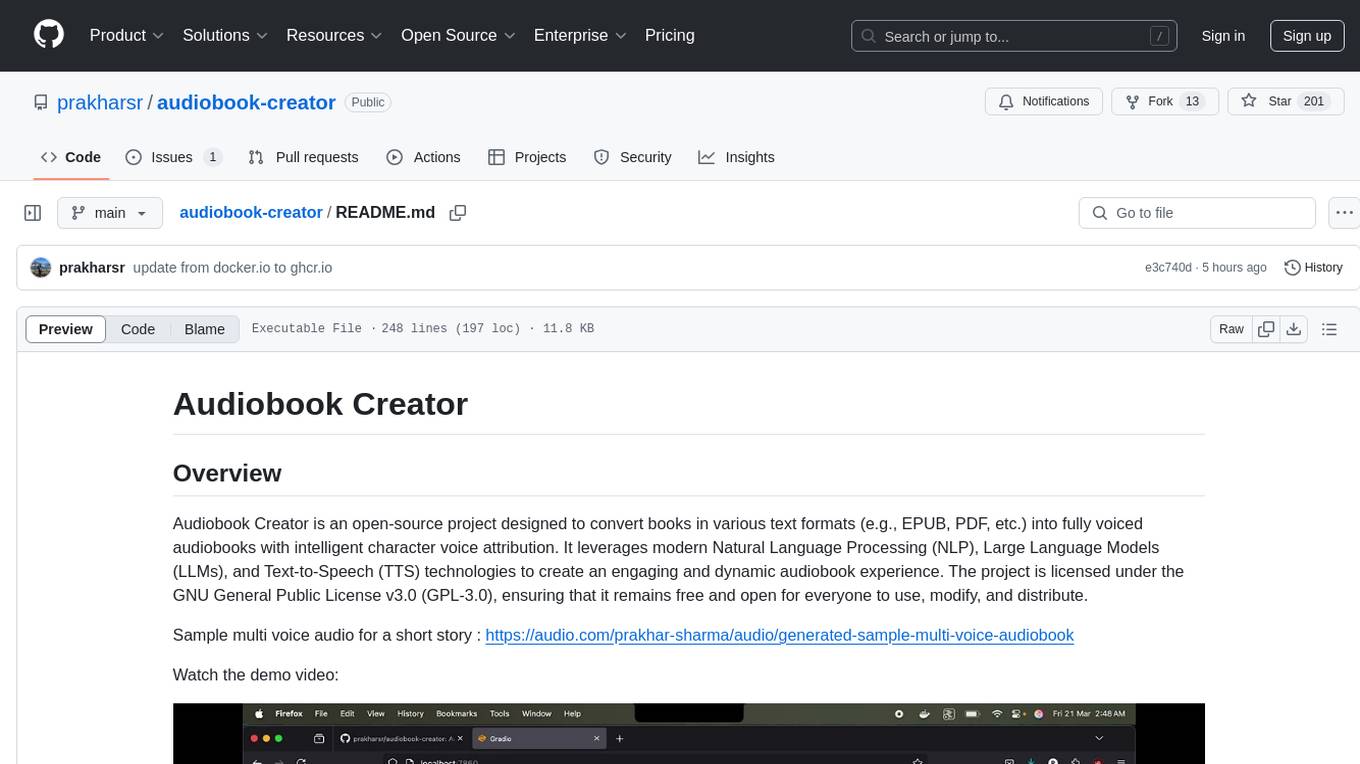
audiobook-creator
Audiobook Creator is an open-source tool that converts books in various text formats into fully voiced audiobooks with intelligent character voice attribution. It utilizes NLP, LLMs, and TTS technologies to provide an engaging audiobook experience. The project includes components for text cleaning and formatting, character identification, and audiobook generation. Key features include a Gradio UI app, M4B audiobook creation, multi-format support, Docker compatibility, customizable narration, progress tracking, and open-source licensing.
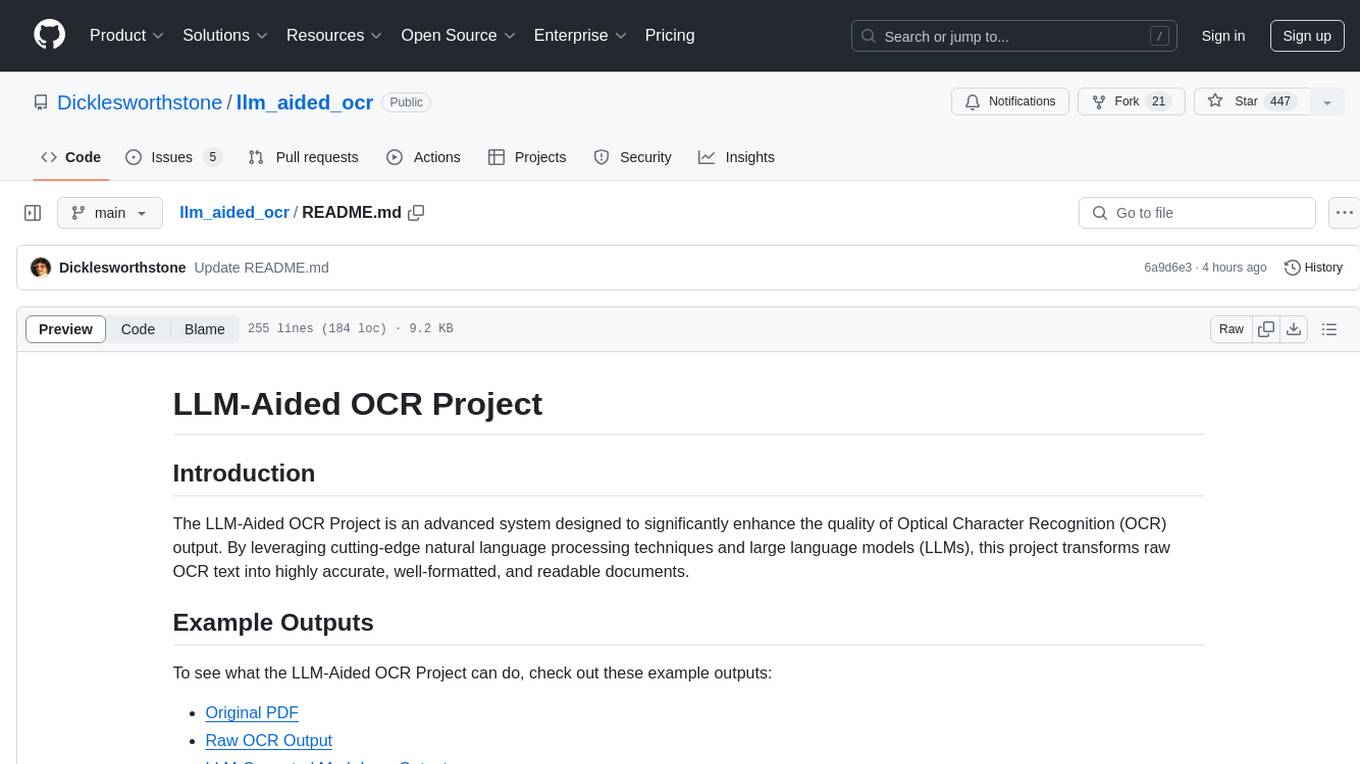
llm_aided_ocr
The LLM-Aided OCR Project is an advanced system that enhances Optical Character Recognition (OCR) output by leveraging natural language processing techniques and large language models. It offers features like PDF to image conversion, OCR using Tesseract, error correction using LLMs, smart text chunking, markdown formatting, duplicate content removal, quality assessment, support for local and cloud-based LLMs, asynchronous processing, detailed logging, and GPU acceleration. The project provides detailed technical overview, text processing pipeline, LLM integration, token management, quality assessment, logging, configuration, and customization. It requires Python 3.12+, Tesseract OCR engine, PDF2Image library, PyTesseract, and optional OpenAI or Anthropic API support for cloud-based LLMs. The installation process involves setting up the project, installing dependencies, and configuring environment variables. Users can place a PDF file in the project directory, update input file path, and run the script to generate post-processed text. The project optimizes processing with concurrent processing, context preservation, and adaptive token management. Configuration settings include choosing between local or API-based LLMs, selecting API provider, specifying models, and setting context size for local LLMs. Output files include raw OCR output and LLM-corrected text. Limitations include performance dependency on LLM quality and time-consuming processing for large documents.
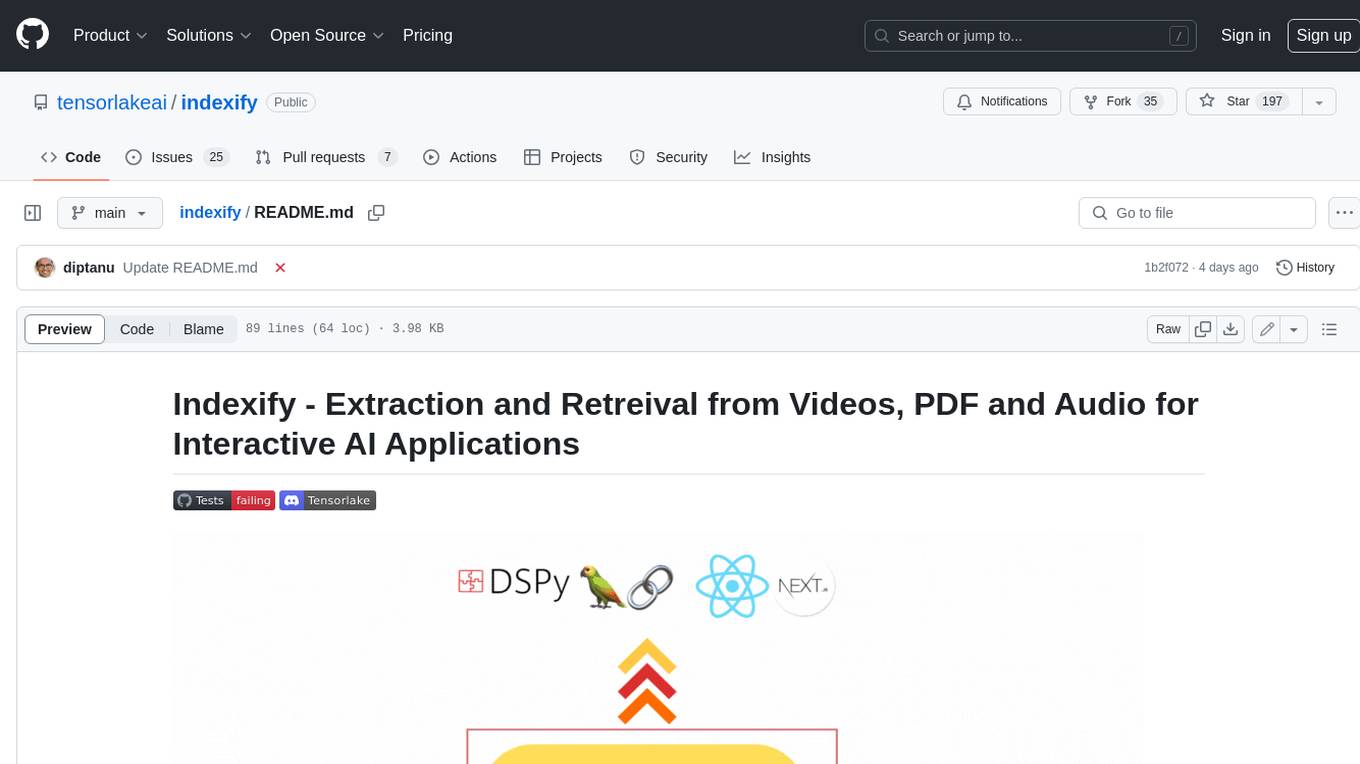
indexify
Indexify is an open-source engine for building fast data pipelines for unstructured data (video, audio, images, and documents) using reusable extractors for embedding, transformation, and feature extraction. LLM Applications can query transformed content friendly to LLMs by semantic search and SQL queries. Indexify keeps vector databases and structured databases (PostgreSQL) updated by automatically invoking the pipelines as new data is ingested into the system from external data sources. **Why use Indexify** * Makes Unstructured Data **Queryable** with **SQL** and **Semantic Search** * **Real-Time** Extraction Engine to keep indexes **automatically** updated as new data is ingested. * Create **Extraction Graph** to describe **data transformation** and extraction of **embedding** and **structured extraction**. * **Incremental Extraction** and **Selective Deletion** when content is deleted or updated. * **Extractor SDK** allows adding new extraction capabilities, and many readily available extractors for **PDF**, **Image**, and **Video** indexing and extraction. * Works with **any LLM Framework** including **Langchain**, **DSPy**, etc. * Runs on your laptop during **prototyping** and also scales to **1000s of machines** on the cloud. * Works with many **Blob Stores**, **Vector Stores**, and **Structured Databases** * We have even **Open Sourced Automation** to deploy to Kubernetes in production.
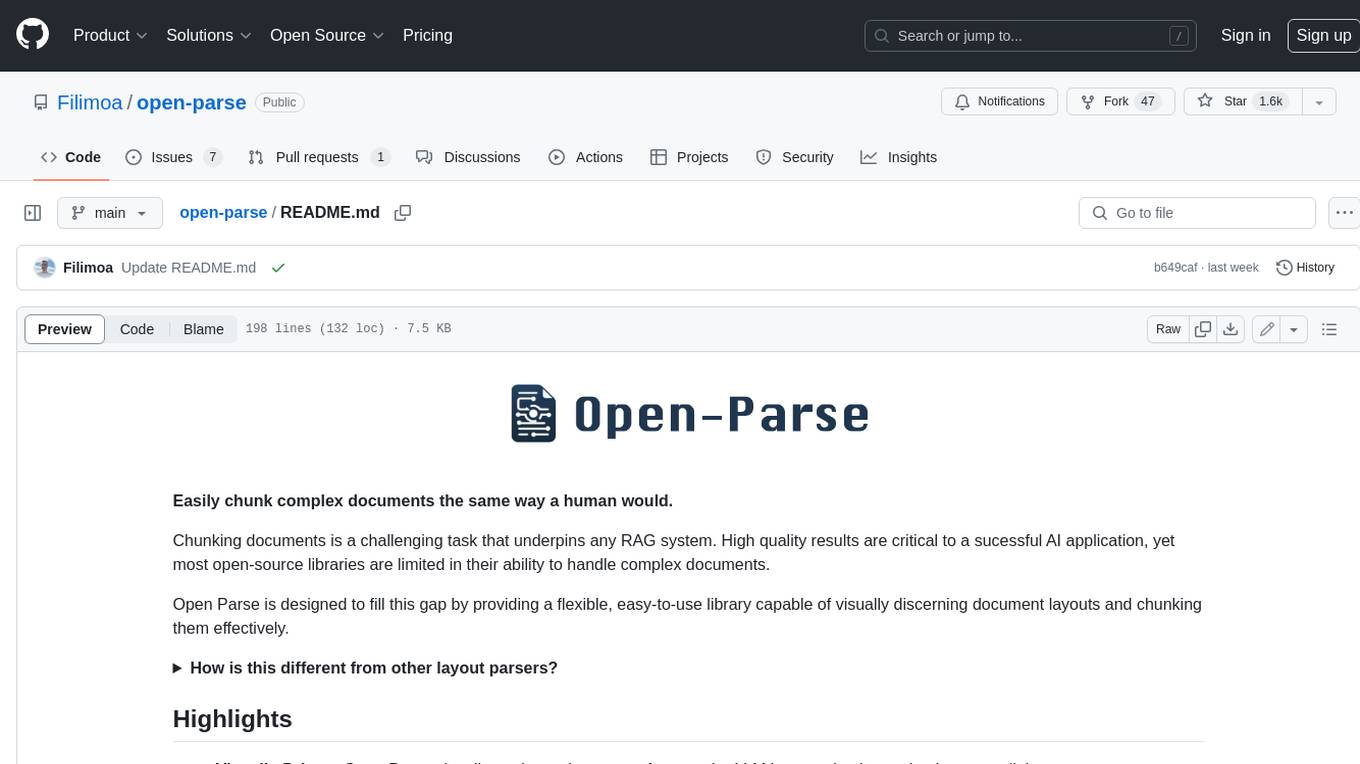
open-parse
Open Parse is a Python library for visually discerning document layouts and chunking them effectively. It is designed to fill the gap in open-source libraries for handling complex documents. Unlike text splitting, which converts a file to raw text and slices it up, Open Parse visually analyzes documents for superior LLM input. It also supports basic markdown for parsing headings, bold, and italics, and has high-precision table support, extracting tables into clean Markdown formats with accuracy that surpasses traditional tools. Open Parse is extensible, allowing users to easily implement their own post-processing steps. It is also intuitive, with great editor support and completion everywhere, making it easy to use and learn.
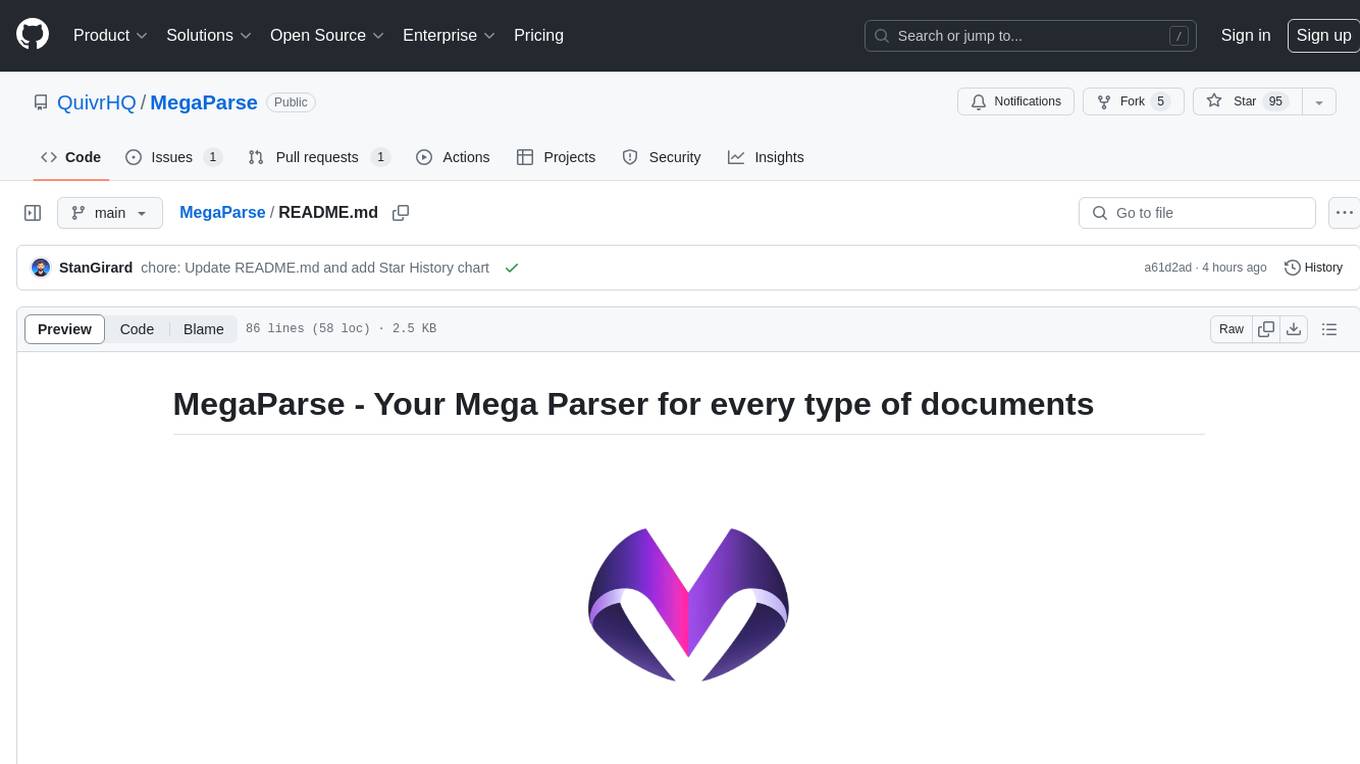
MegaParse
MegaParse is a powerful and versatile parser designed to handle various types of documents such as text, PDFs, Powerpoint presentations, and Word documents with no information loss. It is fast, efficient, and open source, supporting a wide range of file formats. MegaParse ensures compatibility with tables, table of contents, headers, footers, and images, making it a comprehensive solution for document parsing.
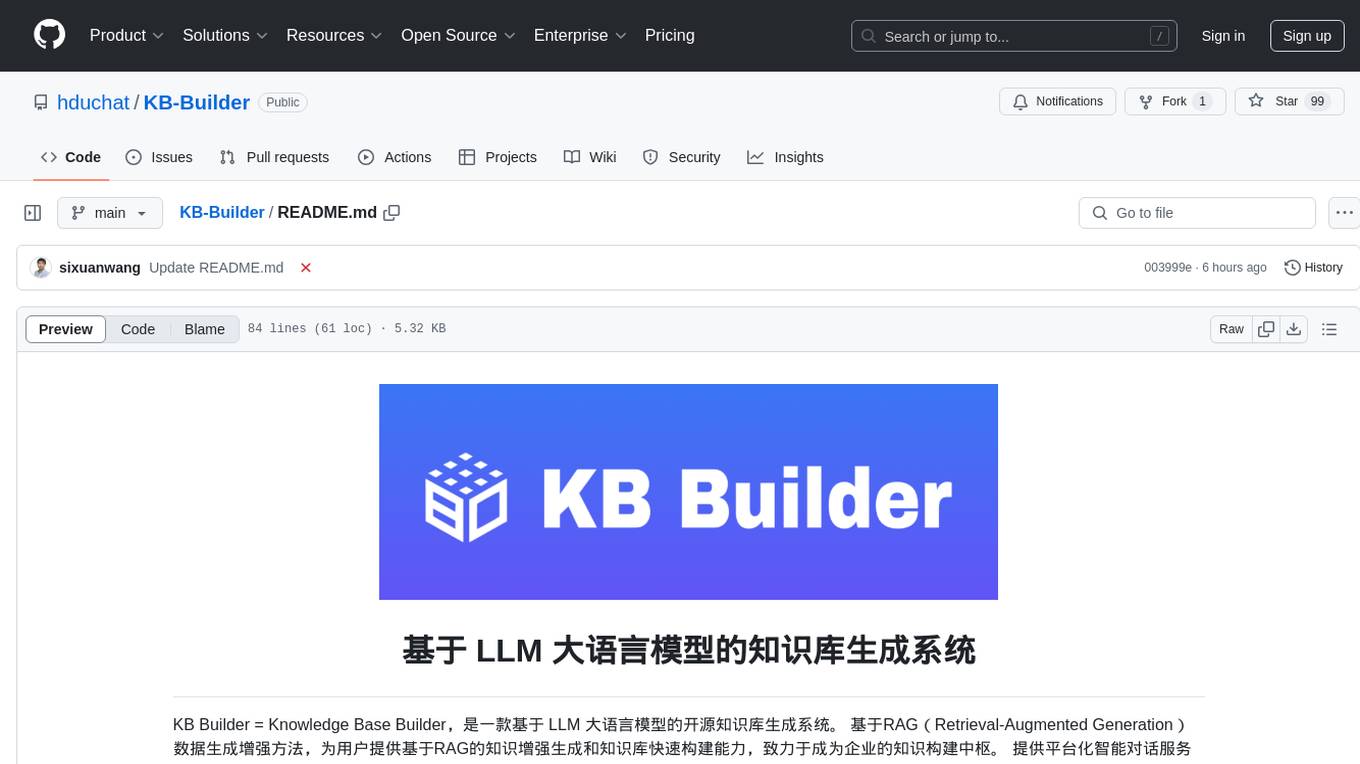
KB-Builder
KB Builder is an open-source knowledge base generation system based on the LLM large language model. It utilizes the RAG (Retrieval-Augmented Generation) data generation enhancement method to provide users with the ability to enhance knowledge generation and quickly build knowledge bases based on RAG. It aims to be the central hub for knowledge construction in enterprises, offering platform-based intelligent dialogue services and document knowledge base management functionality. Users can upload docx, pdf, txt, and md format documents and generate high-quality knowledge base question-answer pairs by invoking large models through the 'Parse Document' feature.
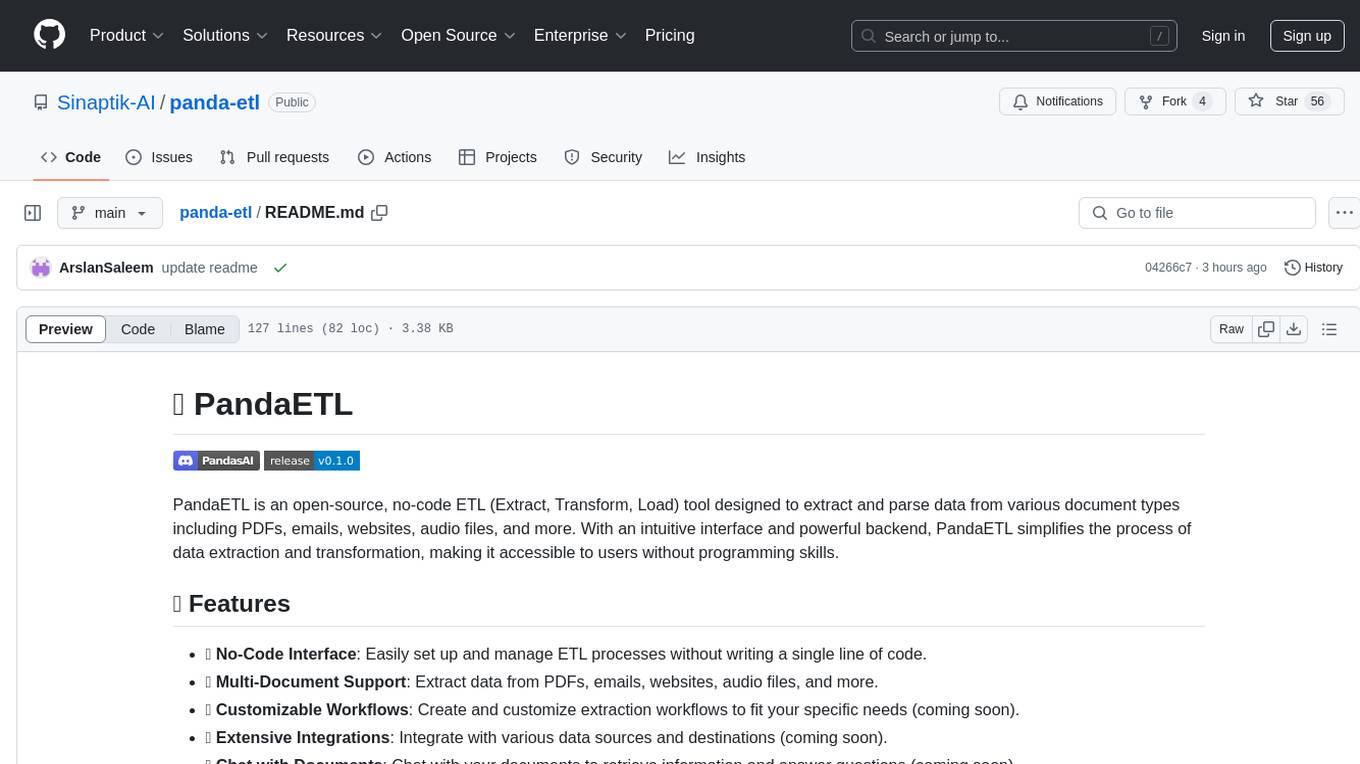
panda-etl
PandaETL is an open-source, no-code ETL tool designed to extract and parse data from various document types including PDFs, emails, websites, audio files, and more. With an intuitive interface and powerful backend, PandaETL simplifies the process of data extraction and transformation, making it accessible to users without programming skills.
For similar jobs

lollms-webui
LoLLMs WebUI (Lord of Large Language Multimodal Systems: One tool to rule them all) is a user-friendly interface to access and utilize various LLM (Large Language Models) and other AI models for a wide range of tasks. With over 500 AI expert conditionings across diverse domains and more than 2500 fine tuned models over multiple domains, LoLLMs WebUI provides an immediate resource for any problem, from car repair to coding assistance, legal matters, medical diagnosis, entertainment, and more. The easy-to-use UI with light and dark mode options, integration with GitHub repository, support for different personalities, and features like thumb up/down rating, copy, edit, and remove messages, local database storage, search, export, and delete multiple discussions, make LoLLMs WebUI a powerful and versatile tool.

Azure-Analytics-and-AI-Engagement
The Azure-Analytics-and-AI-Engagement repository provides packaged Industry Scenario DREAM Demos with ARM templates (Containing a demo web application, Power BI reports, Synapse resources, AML Notebooks etc.) that can be deployed in a customer’s subscription using the CAPE tool within a matter of few hours. Partners can also deploy DREAM Demos in their own subscriptions using DPoC.

minio
MinIO is a High Performance Object Storage released under GNU Affero General Public License v3.0. It is API compatible with Amazon S3 cloud storage service. Use MinIO to build high performance infrastructure for machine learning, analytics and application data workloads.
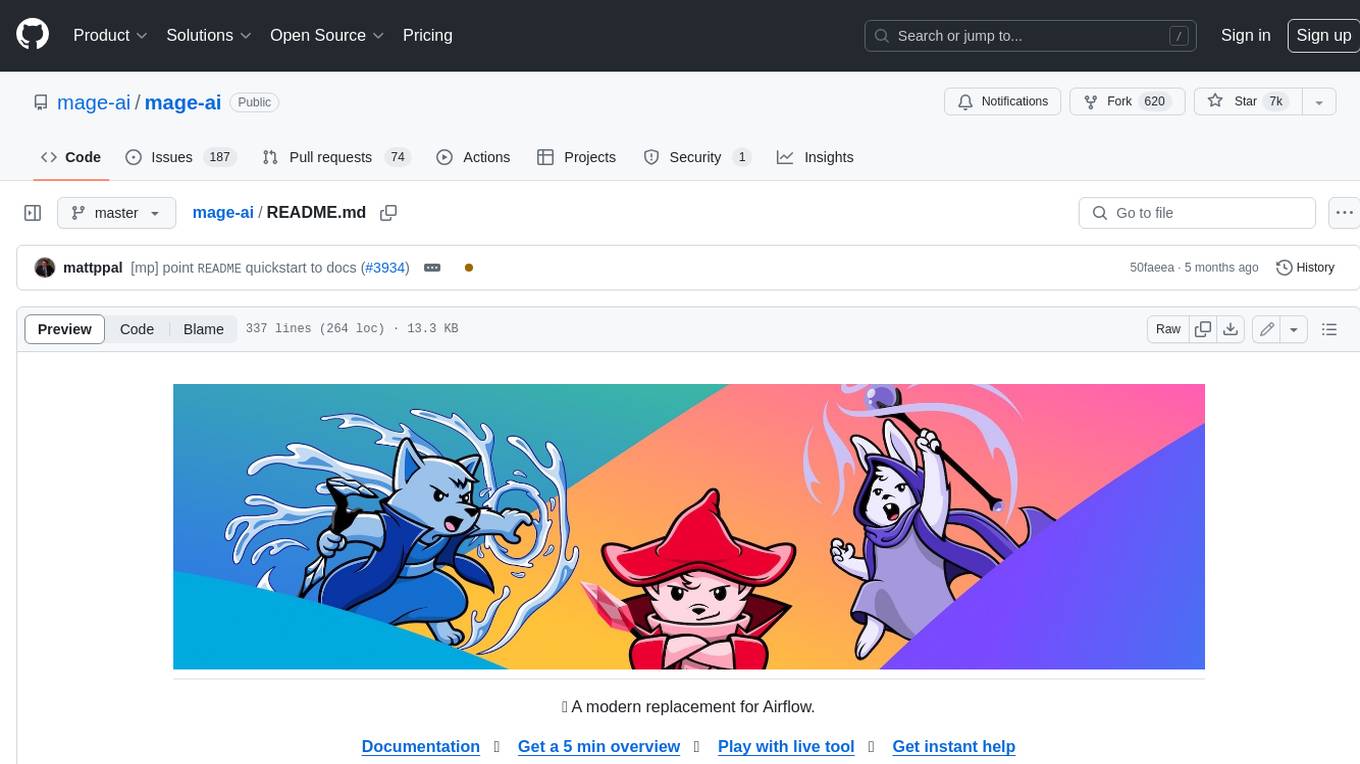
mage-ai
Mage is an open-source data pipeline tool for transforming and integrating data. It offers an easy developer experience, engineering best practices built-in, and data as a first-class citizen. Mage makes it easy to build, preview, and launch data pipelines, and provides observability and scaling capabilities. It supports data integrations, streaming pipelines, and dbt integration.
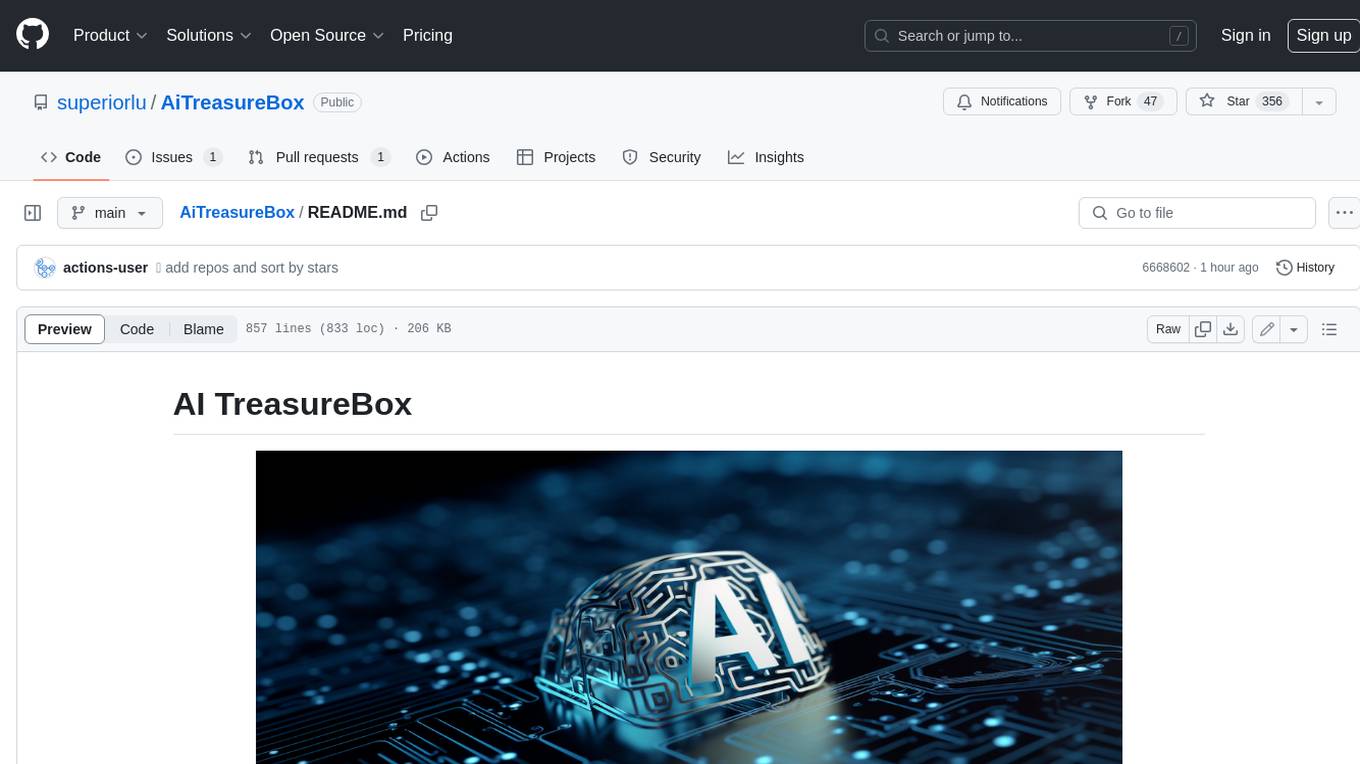
AiTreasureBox
AiTreasureBox is a versatile AI tool that provides a collection of pre-trained models and algorithms for various machine learning tasks. It simplifies the process of implementing AI solutions by offering ready-to-use components that can be easily integrated into projects. With AiTreasureBox, users can quickly prototype and deploy AI applications without the need for extensive knowledge in machine learning or deep learning. The tool covers a wide range of tasks such as image classification, text generation, sentiment analysis, object detection, and more. It is designed to be user-friendly and accessible to both beginners and experienced developers, making AI development more efficient and accessible to a wider audience.

tidb
TiDB is an open-source distributed SQL database that supports Hybrid Transactional and Analytical Processing (HTAP) workloads. It is MySQL compatible and features horizontal scalability, strong consistency, and high availability.
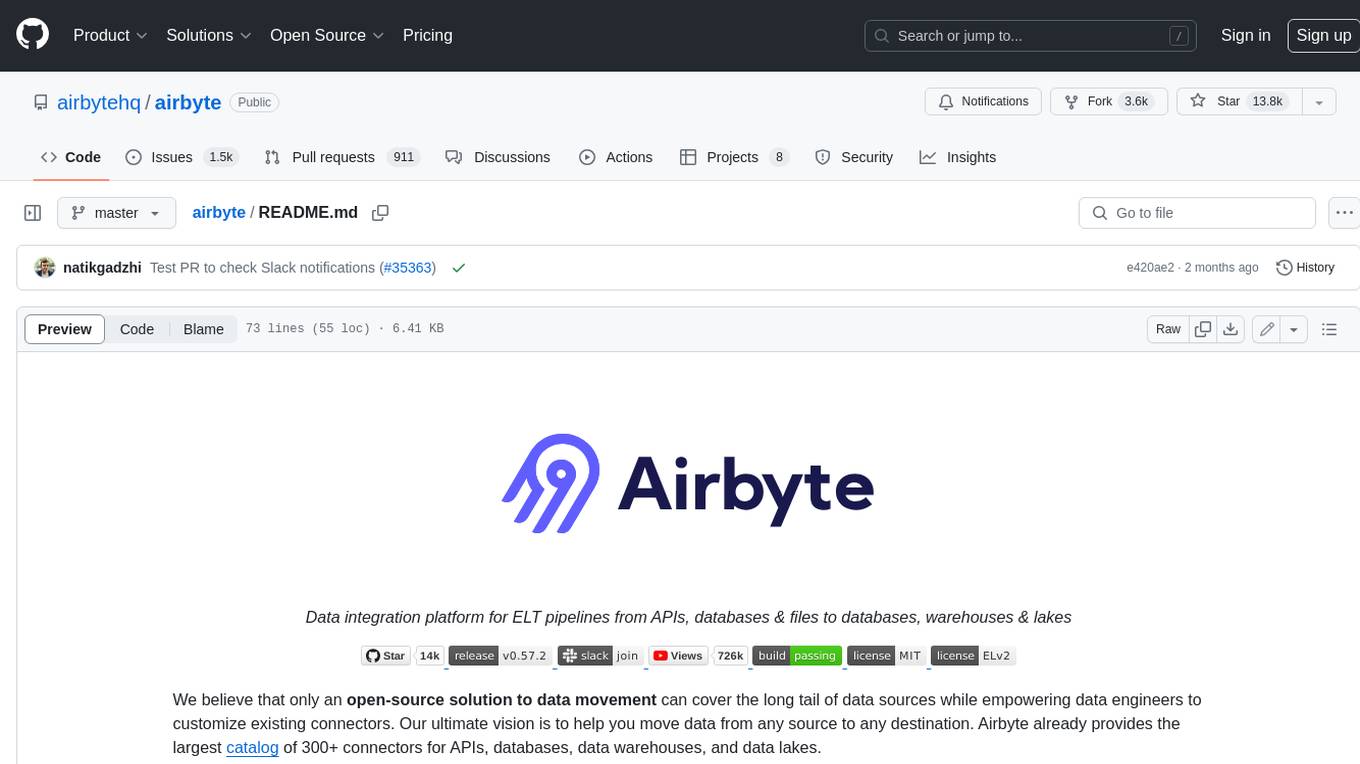
airbyte
Airbyte is an open-source data integration platform that makes it easy to move data from any source to any destination. With Airbyte, you can build and manage data pipelines without writing any code. Airbyte provides a library of pre-built connectors that make it easy to connect to popular data sources and destinations. You can also create your own connectors using Airbyte's no-code Connector Builder or low-code CDK. Airbyte is used by data engineers and analysts at companies of all sizes to build and manage their data pipelines.

labelbox-python
Labelbox is a data-centric AI platform for enterprises to develop, optimize, and use AI to solve problems and power new products and services. Enterprises use Labelbox to curate data, generate high-quality human feedback data for computer vision and LLMs, evaluate model performance, and automate tasks by combining AI and human-centric workflows. The academic & research community uses Labelbox for cutting-edge AI research.










